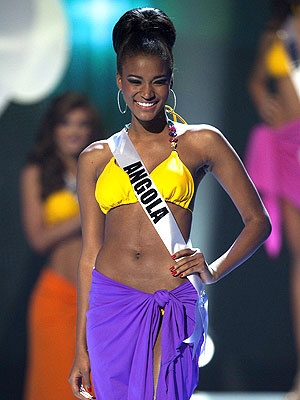Dueling Beauty Pageants Put Income Gap on View
By SIMON ROMERO
Published: November 30, 2010
CARTAGENA, Colombia — The Champagne flowed. Cigar smoke floated in the thick air of the tropical night. Women in miniskirts and men in pressed guayaberas danced at Jet-Set magazine’s fete in this city’s Naval Museum, as the candidates for Miss Colombia sashayed about, flashing perfect smiles and impossibly high cheekbones.
Two Beauty Contests, Two WorldsAnother party unfolded the same night last month outside Cartagena’s stone ramparts. In a slum called Boston, Ivonne Palencia, an elegant 19-year-old, tiptoed in the mud outside her family’s hovel. Amid the din of firecrackers and reggaetón music, neighbors toasted her victory as Miss Independence, the queen of this city’s slums, with beer.
“We have our queen,” said a glowing Patricia Álvarez, 44, a social worker in Boston who led a collection drive to support Ms. Palencia’s candidacy. “They have theirs.”
Despite making strides in stabilizing the economy in the last decade, Colombia has South America’s most unequal distribution of wealth, except for small Paraguay, according to the Center for Economic Development Studies in Bogotá. And each November this port city puts that inequality on open display, when it hosts two beauty pageants at the same time. The rival contests offer views not only of the country’s yawning income gap but of issues of race and class in a country that has, by some measures, the Spanish-speaking world’s largest black population.
Miss Colombia, the better-known event, features two dozen strutting candidates, many of them light-skinned daughters of prominent families. The pageant positions Cartagena as its boosters often market it: a playground for the global elite with $475-a-night boutique hotels and Audis prowling the narrow streets of a colonial gem once coveted by corsairs.
In the shadows of that opulence, Cartagena’s slums hold their own pageant celebrating the city’s declaration of independence from Spain in 1811. Largely featuring Afro-Colombian candidates, the contest, which unfolds during a tumultuous street festival, reveals rival concepts of beauty in a city that was also imperial Spain’s major port of entry for slaves being shipped to its South American colonies.
“One pageant portrays Cartagena as its elite wants it to be seen: rich, white and glamorous,” said Elisabeth Cunin, a French sociologist who studies Cartagena. “The other reflects the reality of the city as the majority of its inhabitants know it: poor and neglected, a complex mix between racial domination and an emerging current of black consciousness.”
The national pageant, founded here in 1934 as a tourism linchpin, employs a multilingual staff at an air-conditioned building in Parque de Bolívar in the old center, attracting sponsors like Edox, a Swiss watch manufacturer. The municipal contest, created in 1937, operates on a shoestring budget from a crumbling structure a few blocks away.
Few nations, with the exception of neighboring Venezuela, attach as much importance to such pageants. In addition to Miss Colombia and Miss Independence, Colombian juries award many lesser titles, like Miss Plantain and Miss Coal. Cellblocks in a Bogotá women’s prison have their own pageants. One town in northern Colombia takes it even further, putting makeup and wigs on its donkeys then parading them for its annual Miss Burro celebration.
No pageant attracts as much obsessive attention as Miss Colombia. Paparazzi swarm the city each November. Gossip columnists speculate about plastic surgery, while investigative journalists try to uncover whether drug kingpins paid the surgeons’ bill. In a further stamp of legitimacy, Colombia’s intellectuals deride the event.
The writer Laura Restrepo skewered the whole scene with the words of a cynical reporter in her novel “The Angel of Galilea.” “Of all my assignments for Somos, covering the pageant was by far the worst, having to rhapsodize on Miss Boyacá’s Pepsodent smile, Miss Tolima’s dubious virginity, Miss Arauca’s preoccupation with poor children.”
One of this year’s candidates boasted that she was studying at DePaul University in Chicago. Yet another emphasized that she was born in Paris. In contrast, the bios from the municipal pageant described one candidate who came from a family of 10 children. Another said she simply dreamed of visiting the capital, Bogotá.
Sometimes the candidates from both pageants have to greet one another, as they did at a military parade one morning in November. Organizers seated them side by side under a canopy shielding them from the sun.
Awkwardness reigned. The mostly fair-skinned Miss Colombia candidates fidgeted. There were attempts at small talk, and smiles for the cameras.
In an interview, Raimundo Angulo, a former mayor of Cartagena who now directs the national pageant, chafed at criticism that his event was somehow racist or excluding. He said the pageant could improve life for residents by helping to make Cartagena into “the Monte Carlo of the Caribbean,” replete with chic casinos and a Formula One race.
“It is democratically elitist,” he contended of his pageant. “I simply want what is beautiful, wherever it comes from, according to certain principles, certain values.”
As Mr. Angulo points out, an Afro-Colombian candidate has even been named Miss Colombia. That happened precisely once in the pageant’s 76-year history, in 2001, when Vanessa Mendoza won the crown. Winners of the local contest sometimes go on to compete in the national pageant the following year.
As with the national pageant, the views here of the local contest are far from unanimous. Some Afro-Colombian leaders see it as a poor imitation of the rival pageant, while reinforcing standards in which women are judged almost solely on their appearance.
Still, it is clear which pageant elicits the most excitement on Cartagena’s streets. The candidates from the slums strut through different districts as the city’s carnivalesque celebration of its independence from Spain unfolds. Shop owners shut early, fearful of assaults. A bawdy parade is led by a troupe dressed as whip-wielding priests pursuing sinners, re-enacting the Spanish Inquisition’s tribunal, once based here.
This year, bystanders greeted them with cries of “Long live our queens!” as they marched through the Getsemaní district. Bands of youths roamed the streets carrying buckets of black paint, threatening to paint the faces of visitors. For a few small bills they would relent.
Within this anarchic scene, a panel chooses a winner. The title of Miss Independence this year went to Ms. Palencia, who took time off from her job as a preschool teacher to compete. Her slum, Boston, said to be named for a red-light district once frequented by foreign sailors, erupted in celebration.
Ms. Palencia’s mother, Yadira Querubín, 50, a maid who earns $6 a day cleaning houses in a rich area of Cartagena, proudly welcomed a visitor into their home, which has a dirt floor that turns into mud when rain leaks through the ceiling. “I’m a maid, and I have a daughter who is a queen,” said Ms. Querubín. “Maybe my lovely girl, from this difficult place, will have a more dignified life than my own.”
Jenny Carolina González contributed reporting from Bogotá, Colombia.






 Reply With Quote
Reply With Quote


















